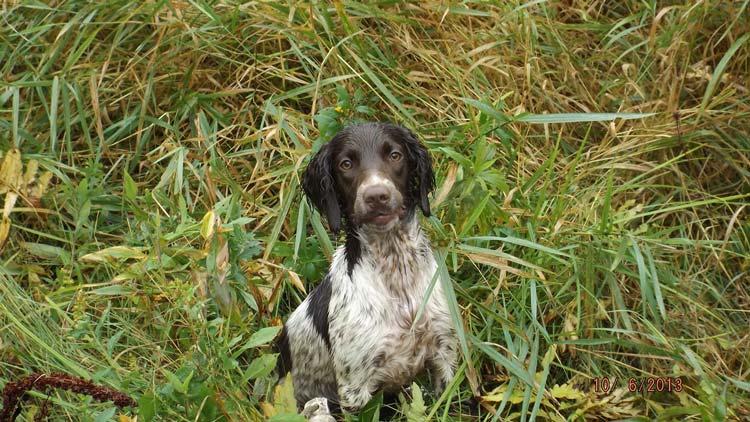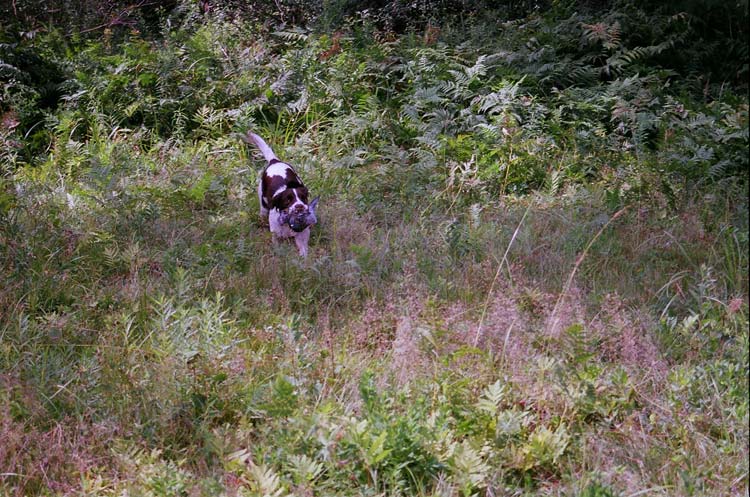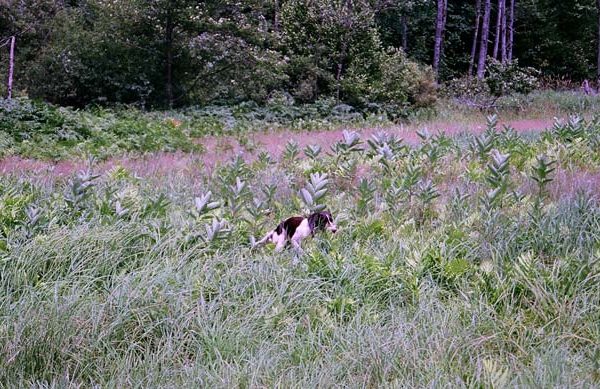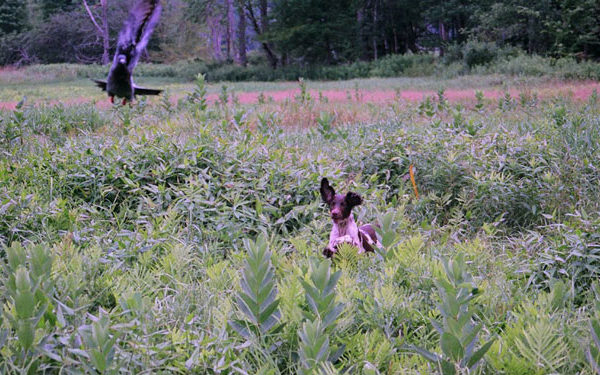
Well, so far we have been focusing our spaniel on the two pieces of the puzzle that is required to construct a blind retrieve. “Lining and Casting”, this month we will start to put the two pieces of the puzzle together. Hopefully you have developed good attitude on the lining and casting drills. Your spaniel now is kicking up some dirt when they are sent on the “BACK” command.
Before I begin this month’s lesson, let’s do a quick review of what our spaniels have learned. They now can perform the three-hand casting drills “COLD”, with a 95 percent success rate. We expect the same in the lining drills during the” pattern blinds”. Additional they are also capable of running a selected line “cold” with the same success rate. It will be nearly impossible to get a consistent 100 percent success rate on all drills every day. There are too many environmental issues in these exercises.
So now it is time to put things together and move forward to the next level of training. Let’s get right to the fun part of schooling the blind retrieve! We are going to use the same area that we previously used for teaching the eight legged pattern blinds. We want to have the pattern blind set up exactly as it was when you were introducing the spaniel to lining. Set out your dummies ahead of time, because we are going to start this new drill COLD.
Choose a line to run with the proper wind direction that will assist your spaniel in being successful. Additional I would also choose the longer line of 100 yards to the dummy pile. Line up your spaniel and send them for a retrieve at the dummy pile. Line them again and send them back to the same pile. When the spaniel is approximately half way to the pile, stop them with your retriever whistle. Naturally they should immediately turn and “HUP” facing you. Set yourself in the Prayer position, count to three, and cast them with hand signal and a verbal “BACK” command.
We want our spaniel to understand from the onsite that they occasionally will be stopped while taking an initial line. My recommendation is to stop the spaniel on one out of every four casts. Most will stop and take the ‘BACK” command without losing stride. However, there are some that will just sit there and refuse to cast back to the pile. In this case, simply move up as close as you need to your spaniel. Give another BACK cast. Often this reinforcement through proximity will be enough to encourage your student to go BACK! For others you may need to throw a dummy to the pile to convince them to continue on their line for a retrieve.
Now a word of caution be careful that you do not stop your spaniel too often while running pattern blinds. This WILL cause the spaniel to begin popping. What do you say is POPPING?? This is when a spaniel will start to automatically stop while in route to a dummy pile turn to the trainer and look for direction for which way to go. Dogs that pop will do this without any whistle command and will lose their intensity as the run to the pile of dummies! This is a highly undesirable trait and is penalized in most field events.
“POPPING” has two common causes. First occurs when the dog is stopped to often on running their initial lines. The spaniel will start to anticipate the whistle command to stop before it happens beating you to whistle so to say. This will cause them to loose there intensity and attitude on taking and running the initial line. The second cause for popping occurs when the spaniel is stopping and cast with left or right overs to often as well. The trainer has failed to give the dog enough independence to hunt their birds. This makes the spaniel stop and look for direction or (reaffirming) with the trainer while questing for game. In either case, the spaniel is out of balance and has lost their independence and will not hunt for the bird through the sent cone.
This highly undesirable we want a balanced dog that will take direction only when needed but still has the strong desire to please and seek game independently. We want to continue the drill through all of the other legs on the wagon wheel. Stop your student at random distances while taking the initial line. Teach the spaniel to stop and face you in all different wind directions. Be sure to continue driving the dog all the way to the same dummy pile several times to maintain good solid attitude on running the initial line. Once this is learned, you will transition to a related advancing drill.
Line the spaniel to a 100 yard pile, using the same initial line throughout our session. Stop the spaniel at 60 yards out, and give them a left or right handed cast to a pile adjacent to the initial line. We now want them to make a retrieve from the adjacent pile of dummies. Like all drills, it is best to use the wind to your advantage in the beginning stages of this new drill. There noise will help to SUCK them to the pile of dummies for the retrieve. Continue to drill this in every different wind direction so they gain in confidence on your cast. Mix it up cast your left and right OVERS, HUP and BACK commands as well as driving them straight through to the pile without being handled.
Again keep this important factor in mind only stop your spaniel for a cast once out of every four times you send them on their initial line. You should be sending them straight on through to pile more than you are stopping them for a handling cast. Remember when they freeze up and refuse to take a cast. Simply move up to help them understand what you are asking them to do. Remember we are teaching them to leave their initial line and take an Over cast until they find the blind bird. You can even mix it up and use a 60 yard line as the initial line, stop them half way, cast them over to a 100 yard line stop them again then send them on a Back command to the pile of dummies.
However you maintain and teach them that the initial line is the most productive line to take for making the retrieve on a blind. Again drill this more often than stopping and casting them. Remember we are only going to handle them on blinds when. They drift too far off the initial line, or to keep them on the proper downwind side of the fallen bird so they can locate the sent cone to suck them into the retrieve. We are getting very close to running Cold blinds. Keep in mind while teaching this part of handling, be cautious and don’t be too harsh on your reprimands. This will cause them to freeze up in the fear of making a mistake. You will see a lot of “no goes” and” cast refusals” during this schooling. Be patient and continue to move up and show them what you are asking them to do. Many time I have thrown a dummy to the pile to get them to go in the direction that I got a “cast refusal”. Remember even though this is a difficult training concept. It still must be fun both of you and your spaniel! Next month the real deal cold blind.





